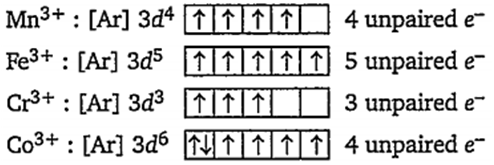 Multiple Choice Questions
Multiple Choice QuestionsWhich of the following two ions have the same number of unpaired electrons ?
(1) Mn3+ (2) Fe3+ (3) Cr3+ (4) Co3+
(2) and (3)
(3) and (4)
(1) and (2)
(1) and (4)
D.
(1) and (4)

Hence, Mn3+ and Co3+ ions have the same number of unpaired electrons.
The lanthanoid contraction is responsible for the fact that
Zn and Y have about same radius
Zr and Nb have similar oxidation states
Zr and Hf have about the same radius
Zr and Zn have the same oxidation state
The equivalent weight of MnSO4, is equal to its molecular weight when it is converted to
Mn2O3
MnO2
MnO
MnO
The mineral from which potassium permanganate is manufactured
manganite, Mn2O3.H2O
pyrolusite, MnO2
Both (a) and (b)
None of the above
The aqueous ferrous ion is green, ferric ion is pale yellow. The aqueous chromic ion is green, hence the colour of chromate ion must be
orange
colourless
yellow
red
belongs to IIIB group of the Periodic.When it loses one α -particle, the new element will belong to the group.
I B
V B
I A
III B
Which set of elements have nearly the same atomic radii ?
F, Cl, Br, I
Na, K, Rb, Cs
Fe, Co, Ni, Cu
Li, Be, B, C
